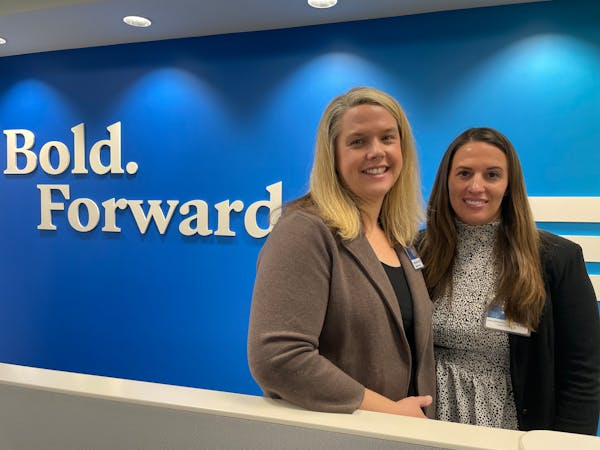Gustavus Adolphus College is the kind of place where, when the temperature is 20 degrees above average in mid-November, a biology professor will hold class outside and students will write equations in chalk on a sidewalk.
The school of 2,200 students in the southern Minnesota town of St. Peter is ranked by the Wall Street Journal as the best college in Minnesota at delivering value for its cost. It's tied with Macalester College in St. Paul as having the most economically diverse student body in the state in a study by the New York Times.
Despite such laudable marks, first-year student enrollment declined in 2020, 2021 and 2022 before moving back upward this fall.
"For a tuition-driven school like Gustavus, enrollment is key," said Rebecca Bergman, the college's president since 2014. "Without that, you pretty quickly get on a slippery slope of future challenges."
There's a slope ahead anyway. U.S. births peaked in 2007, which means the number of kids coming out of high school will start to drop in 2025. That challenge is coming after a decade in which the percentage of high school graduates heading straight to college has fallen amid negative perceptions over costs and campus politics.
On top of that, legislators this spring made tuition in Minnesota's state colleges free for students from families with incomes of less than $80,000, forcing private schools like Gustavus to reassess their own costs and aid.
The deadline for early admission applicants at Gustavus passed last week, giving its leaders a first glimpse into what enrollment might be next fall.
The news was good. Applications rose, said Kim Frisch, the school's new vice president of enrollment.
As Bergman discussed the challenges facing colleges, she said she was not worried about Gustavus' ability to compete. "Now, does that mean we sit back and rest easy? Oh no," she said.
When I reached out to learn how Gustavus climbed those rankings, I thought I'd hear about things the college did years ago. Instead, Bergman and colleagues told me what's happening right now and I learned the answer is that Gustavus doesn't sit back, still or around.
Last month, faculty members approved a new curriculum to fix a problem that crept up on them and to make a clearer case for the value of a Gustavus education.
Through the years, Gustavus had slowly added more required courses, reaching about 45% of a student's total. With some majors consuming another 45%, students had little time to explore other subjects. "That's long been the model," said Brenda Kelly, the school's provost.
Students felt constrained by the requirements so leaders decided to fix it. Some came from high schools that cut back on electives in the pandemic, which meant they had no chance to learn a foreign language or take an art class.
Starting next fall, Gustavus students will spend about one-third of their time in required general courses, one-third in a major and one-third for exploration. "We may have more students who do double majors or three minors, but I'm glad they have the opportunity to decide," Kelly said.
The new curriculum incorporates a "signature experience" focused on an individual's expected career, such as study overseas, an internship or individual project. Many students already take those extra steps, but faculty members decided to making sure everyone will.
"The current moment has forced us to explain why," said Kate Knutson, a political science professor who served on the task force that led the overhaul. "Why should someone spend four years of their life and possibly a lot of money, although Gustavus does a great job with financial aid? Why is it worth it?"
The curriculum change happened quickly — six months after the first meeting of the task force — though not easily, Knutson said. "Nobody likes letting go of things. It's much easier to just add," she said.
Some changes at Gustavus are easier. One is a rebranding of financial aid.
About 10% of Gustavus' students would qualify for free tuition at state-run schools under the program, called the North Star Promise, approved by legislators this spring. Gustavus added up its aid to that group and found it easily matched the free tuition promise while getting more students to finish their degrees on time. With the state aid getting such attention, Gustavus put a name, the "Gustie Guarantee", on its program.
Frisch, the enrollment chief who moved to Minnesota from fast-growing Colorado this summer, said private schools like Gustavus should be working with public ones to encourage more Minnesotans to stay in the state for college. Demographic data shows that college students are the greatest source of population loss for Minnesota.
"We need to start promoting harder and stronger why college-bound students need to stay in the state," Frisch said. "With the caliber of both private and public colleges and universities, there are too many opportunities here for them to be leaving at such a high percentage."

Ramstad: Minnesota demographer takes deeper look at migration, workforce pressure
Ramstad: Health care is a tough arena for AI to make a difference
Ramstad: Misinterpreting data led me to the wrong conclusion about Minnesota retirees
Ramstad: How Rochester is keeping its housing growth on track





